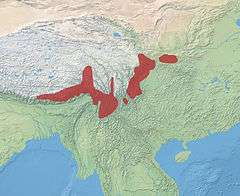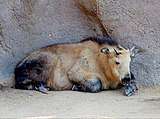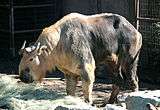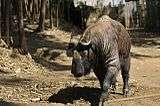Takin
The takin (/ˈtɑːkɪn/; Budorcas taxicolor; Tibetan: ར་རྒྱ་, Wylie: ra rgya ), also called cattle chamois or gnu goat,[2] is a large species of ungulate of the subfamily Caprinae found in the eastern Himalayas. The four subspecies are the Mishmi takin (B. t. taxicolor), the golden takin (B. t. bedfordi), the Tibetan (or Sichuan) takin (B. t. tibetana), and the Bhutan takin (B. t. whitei).
| Takin | |
|---|---|
.jpg) | |
| Takin at Roger Williams Park Zoo in Providence, Rhode Island. | |
| Scientific classification | |
| Kingdom: | Animalia |
| Phylum: | Chordata |
| Class: | Mammalia |
| Order: | Artiodactyla |
| Family: | Bovidae |
| Subfamily: | Caprinae |
| Genus: | Budorcas Hodgson, 1850 |
| Species: | B. taxicolor |
| Binomial name | |
| Budorcas taxicolor Hodgson, 1850 | |
| Subspecies | |
|
B. t. bedfordi | |
 | |
| Distribution of the takin | |
Whilst the takin has in the past been placed together with the muskox in the tribe Ovibovini, more recent mitochondrial research shows a closer relationship to Ovis (sheep). Its physical similarity to the muskox is therefore an example of convergent evolution.[3] The takin is the national animal of Bhutan.[4]
Appearance
The takin rivals the muskox as the largest and stockiest of the subfamily Caprinae, which includes goats, sheep, and similar species. Its short legs are supported by large, two-toed hooves, which each have a highly developed spur.[2][5] It has a stocky body and a deep chest. Its large head is distinctive by its long, arched nose and stout horns, which are ridged at the base. These horns are present in both sexes, and run parallel to the skull before turning upwards to a short point; they are about 30 cm (12 in) long, but can grow up to 64 cm (25 in).[2] Its long, shaggy coat is light in color with a dark stripe along the back,[2] and males (bulls) also have dark faces.[5]
Four subspecies of takin are currently recognised, and these tend to show a variation in coat color. Their thick wool often turns black in color on their undersides and legs. Their overall coloration ranges from dark blackish to reddish-brown suffused with grayish-yellow in the eastern Himalayas to lighter yellow-gray in the Sichuan Province to mostly golden or (rarely) creamy-white with fewer black hairs in the Shaanxi Province.
The legend of the 'golden fleece', searched for by Jason and the Argonauts,[6] may have been inspired by the lustrous coat of the golden takin (B. t. bedfordi).[5] Hair length can range from 3 cm (1.2 in), on the flanks of the body in summer, up to 24 cm (9.4 in) on the underside of the head in winter.
In height, takin stand 97 to 140 cm (38 to 55 in) at the shoulder, but measure a relatively short 160–220 cm (63–87 in) in head-and-body length, with the tail adding only an additional 12 to 21.6 cm (4.7 to 8.5 in). Measurements of weights vary, but according to most reports, the males are slightly larger, weighing 300–350 kg (660–770 lb) against 250–300 kg (550–660 lb) in females.[7] Sources including Betham (1908) report that females are larger, with the largest captive takin known to the author, at 322 kg (710 lb), having been female. Takin can weigh up to 400 kg (880 lb) or 600 kg (1,300 lb) in some cases.[8][9]
Rather than localised scent glands, the takin secretes an oily, strong-smelling substance over its whole body.[5] This is likely the reason for the swollen appearance of the face. Due to this feature, biologist George Schaller likened the takin to a "bee-stung moose."[4] Their combination of features has also earned them the nicknames "cattle chamois" and "gnu goat".
Habitat
Takin are found from forested valleys to rocky, grass-covered alpine zones, at altitudes between 1,000 and 4,500 m (3,300 and 14,800 ft) above sea level.[2] The Mishmi takin occurs in eastern Arunachal Pradesh, while the Bhutan takin is in western Arunachal Pradesh and Bhutan.[10] Dihang-Dibang Biosphere Reserve in Arunachal Pradesh,India is a stronghold of both Mishmi, Upper Siang (Kopu)[11] and Bhutan takins.[12] An actively breeding herd of Takin in North America can be found at the Wilds in Cumberland, Ohio. They are part of a Species Survival Plan (SSP) through the Association of Zoos and Aquariums. A captive population also exists at Minnesota Zoo in the United States.[13] There is also a group of takin on display at the San Diego Zoo, The Los Angeles Zoo, The Red River Zoo in North Dakota, the Roger Williams Park Zoo in Rhode Island, and Riverview Park & Zoo in Peterborough, Ontario, Canada.
Biology
Takin are found in small family groups of around 20 individuals, although older males may lead more solitary existences. In the summer, herds of up to 300 individuals gather high on the mountain slopes.[2] Groups often appear to occur in largest numbers when favorable feeding sites, salt licks, or hot springs are located. Mating takes place in July and August. Adult males compete for dominance by sparring head-to-head with opponents, and both sexes appear to use the scent of their own urine to indicate dominance. A single young is born after a gestation period of around eight months.[2] Takin migrate from the upper pasture to lower, more forested areas in winter and favor sunny spots upon sunrise.[2] When disturbed, individuals give a 'cough' alarm call and the herd retreats into thick bamboo thickets and lies on the ground for camouflage.[6]
Takin feed in the early morning and late afternoon, grazing on a variety of leaves and grasses, as well as bamboo shoots and flowers.[6] They have been observed standing on their hind legs to feed on leaves over 3.1 m (10 ft) high. Salt is also an important part of their diets, and groups may stay at a mineral deposit for several days.[2]
They overlap in range with multiple potential natural predators including the Asiatic black bear and the leopard, and (more seldomly) tigers, Himalayan wolves, snow leopards, and dholes. Anecdotally, both bears and wolves have been reported to prey on takin when they can, which is likely given the opportunistic nature of those predators. However, the only confirmed natural predator of takin is the snow leopard, although mature adults may be exempted from regular predation (due to their size) from that predator. The main predator of takin are humans, who hunt them usually for meat (considered delicious by local people), though secondarily for their pelts. Humans have long since exploited takin's fondness for salt licks, where they are easily cornered and killed. Takin are likely still occasionally killed.
Status
Largely due to overhunting and the destruction of their natural habitat, takin are considered Endangered in China and Vulnerable per the IUCN. Though they are not a common species naturally, their numbers appear to have been reduced considerably. Takin horns have appeared in the illegal wildlife trade in Myanmar, and during three surveys carried out from 1999-2006 in the Tachilek market a total of 89 sets of horns were observed openly for sale [14].
Gallery
 A wild herd in Gongshan Derung and Nu Autonomous County, Yunnan Province, China
A wild herd in Gongshan Derung and Nu Autonomous County, Yunnan Province, China Sichuan Takin on a tree stump at Potawatomi Zoo, South Bend, Indiana
Sichuan Takin on a tree stump at Potawatomi Zoo, South Bend, Indiana_in_Korkeasaari_Zoo%2C_Helsinki%2C_Finland.jpg) A Mishmi takin in Korkeasaari Zoo, Helsinki, Finland
A Mishmi takin in Korkeasaari Zoo, Helsinki, Finland- A baby Sichuan takin in the Lincoln Park Zoo, Chicago
 A Sichuan takin at the San Diego Zoo
A Sichuan takin at the San Diego Zoo An adult Sichuan takin at the San Diego Zoo
An adult Sichuan takin at the San Diego Zoo.jpg) Golden Takin at the Paris Menagerie
Golden Takin at the Paris Menagerie- Golden takin at the Shanghai Zoo

 Bhutanese Takin
Bhutanese Takin
References
- This article incorporates text from the ARKive fact-file "Takin" under the Creative Commons Attribution-ShareAlike 3.0 Unported License and the GFDL.
- Yanling, S.; Smith, A.T. & MacKinnon, J. (2008). "Budorcas taxicolor". IUCN Red List of Threatened Species. 2008. Retrieved 31 March 2009.CS1 maint: ref=harv (link) Database entry includes a brief justification of why this species is of vulnerable.
- Animal Diversity Web (November, 2002) "Budorcas taxicolor" (University of Michigan Museum of Zoology) via arkive.org
- Pamela Groves, Gerald F. Shields, CytochromeBSequences Suggest Convergent Evolution of the Asian Takin and Arctic Muskox, Molecular Phylogenetics and Evolution, Volume 8, Issue 3, December 1997, Pages 363-374, ISSN 1055-7903, doi:10.1006/mpev.1997.0423.
- Tashi Wangchuk (2007). "The Takin - Bhutan's National Animal". In Lindsay Brown; Stan Armington (eds.). Bhutan. Lonely Planet. p. 87. ISBN 978-1-74059-529-2. Retrieved 15 September 2011.
- Macdonald, D. (2001) The New Encyclopedia of Mammals. Oxford University Press, Oxford. via arkive.org
- Huffman, Brent. "Budorcas taxicolor" Ultimate Ungulate via arkive.org
- WWF: Takin
- "Budorcas taxicolor (takin)". Animal Diversity Web. Retrieved 21 March 2018.
- Smith, A. T., Xie, Y. (eds.) (2008) A Guide to the Mammals of China. Princeton University Press, Princeton Oxforshire. Page 472.
- Choudhury, A.U. (2003). The Mammals of Arunachal Pradesh. Regency Publications, New Delhi. 140pp
-
Dasgupta, S., Sarkar, P., Deori, D., Kyarong, S., Kaul, R., Ranjitsinh, M. K. & Menon, V. 2010 Distribution and Status of Takin (Budarcos taxicolor)along the Tibet, Myanmar and Bhutan border in India. A report of Wildlife Trust of India submitted to CEPF. 47 pages.
- Archived 2013-04-25 at the Wayback Machine- Pseudorcas taxicolor profile by Neas and Hoffman (1987)
- Choudhury, A.U. (2010). Mammals and Birds of Dihang – Dibang Biosphere Reserve, North-east India. Lambert Academic Publishing, Saarbrücken, Germany. 104pp.
- Minnesota Zoo (March, 2008) "Takin" mnzoo.com Retrieved 2011-09-15
- Shepherd and Nijman (2016)
- Shepherd, C. R. and Nijman, V. (2016). Observations of Takin from wildlife markets in Myanmar and a call for further research. Caprinae, Newsletter for the Caprinae Specialist Group, August 2016: 16-19.
Further reading
- Maurice Burton; Robert Burton (January 2002). The international wildlife encyclopedia. Marshall Cavendish. pp. 2623–4. ISBN 978-0-7614-7285-8. Retrieved 15 September 2011.
External links
| Wikimedia Commons has media related to: |
| Wikispecies has information related to Budorcas taxicolor |
